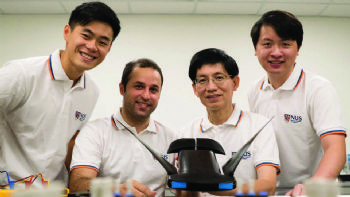
Researchers at the National University of Singapore (NUS) (
www.nus.edu.sg) have built an underwater robot — called MantaDroid — that looks like (and swims like) a manta ray.
The latter is considered one of nature’s most graceful and efficient swimmers, gliding through the water with no apparent effort. There is great interest in understanding the mechanism used and using it for autonomous underwater vehicles (AUVs).
A research team led by Chew Chee Meng and Yeo Khoon Seng at the NUS Faculty of Engineering developed MantaDroid, which resembles a juvenile manta ray.
Just 35cm long, 63cm wide and weighing 0.7kg, it can swim at 0.7m per sec for up to 10hr.
It was designed and optimised over two years after an in-depth study of fluid dynamics and multiple experiments that included testing 40 different fin designs — ending up with a pair of flexible pectoral fins made using PVC sheets.
Chew Chee Meng said: “Unlike other underwater robots that replicate the manta ray’s kinematics by using multiple motors to achieve actuation throughout the fins, MantaDroid is powered by only one electric motor on each fin.
We then let the passive flexibility of the fins interact naturally with the fluid dynamics of the water to propel the robot.”
“MantaDroid is a promising alternative to the propeller-based thrusters used in conventional AUVs, and it could potentially have a longer range.
Like the real manta ray, it also has a flat and wide body that can accommodate a range of sensors and be used for different purposes such as studying marine biodiversity, measuring hydrographic data and performing search operations.